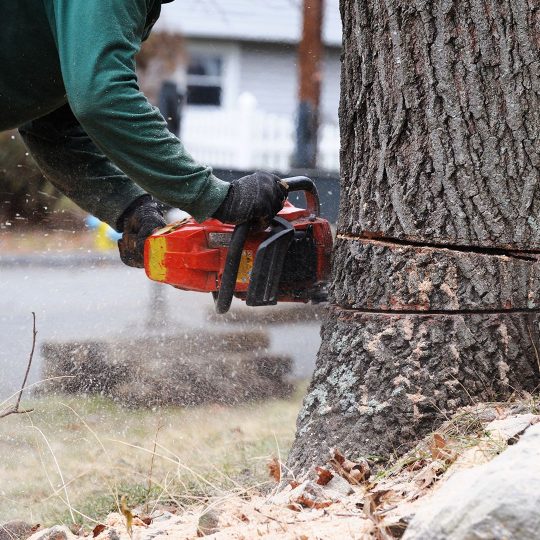When it comes to caring for our natural surroundings, there is an art to shaping and maintaining trees. Tree removal and tree trimming are two essential practices that play a significant role in both our safety and the overall health of the environment. Understanding the secrets behind these processes can help us appreciate the delicate balance between tree preservation and the need for necessary interventions.
Tree removal, as the name suggests, involves the careful and precise elimination of a tree from a specific location. Whether it’s due to disease, structural instability, or the need for space, the decision to remove a tree requires careful assessment and expert guidance. While it may seem counterintuitive to some, removing a tree can sometimes be the best course of action for the overall well-being of the ecosystem.
On the other hand, tree trimming is a proactive approach that focuses on maintaining the health and aesthetic appeal of trees. By selectively removing dead or damaged branches, tree trimming enhances a tree’s structural integrity, promotes growth, and reduces the risk of potential hazards. Skilled arborists employ their expertise to carefully shape trees, ensuring they thrive in their surroundings while preserving their natural beauty.
As we delve into the art of tree trimming and removal, we will explore the techniques, tools, and considerations involved. It is through this knowledge that we can truly appreciate the efforts taken to strike the ideal equilibrium between preserving nature’s wonders and protecting ourselves and our surroundings. Join us as we unveil the secrets of this vital practice and embark on a journey of discovery into the world of tree shaping.
The Importance of Tree Removal
Trees are essential components of our natural environment, providing us with numerous benefits that enhance our quality of life. However, there are instances when tree removal becomes necessary. Whether it is due to safety concerns, disease, or the need for urban development, the removal of trees should be approached with careful consideration.
Firstly, the safety aspect of tree removal cannot be ignored. Trees that are damaged, diseased, or structurally compromised pose a significant risk to people and property. Falling branches or uprooted trees can cause serious accidents and damage during storms or strong winds. In such cases, the removal of these hazardous trees is crucial to ensure the safety of individuals and maintain the integrity of surrounding structures.
Additionally, tree removal may be necessary for the health of the remaining trees in an area. Certain diseases or infestations can spread quickly among trees, jeopardizing the overall health and vitality of the local ecosystem. By identifying and eliminating diseased or pest-infested trees, we can prevent the further spread of these threats and protect the well-being of the surrounding vegetation.
Lastly, the need for urban development often requires the removal of trees. As cities expand and infrastructural projects take shape, trees may need to be cleared to make way for roads, buildings, or other essential structures. While this can be a difficult decision to make, it is important to balance the preservation of our natural environment with the progress and development of our communities.
In conclusion, tree removal plays a crucial role in ensuring the safety, health, and progress of our urban environments. By carefully assessing the need for removal and taking appropriate measures, we can mitigate potential hazards, preserve the health of surrounding trees, and enable responsible urban development.
Methods and Techniques for Tree Trimming
-
Pruning: One of the most common methods for tree trimming is pruning, which involves selectively removing branches or foliage. Pruning helps to enhance the tree’s shape, promote healthier growth, and improve its overall aesthetics. By carefully trimming away dead or diseased branches, the tree can thrive and maintain its structural integrity.
-
Crown Thinning: Another technique used for tree trimming is crown thinning. This method involves selectively removing branches from the tree’s canopy to reduce its density. Crown thinning allows for better air circulation, improved sunlight penetration, and reduced wind resistance. By removing specific branches strategically, the tree can maintain a balanced and visually pleasing appearance.
-
Crown Raising: When it comes to maintaining a tree’s surroundings or ensuring clearance for structures, crown raising is a suitable technique. Crown raising involves removing the lowest branches of the tree to increase the clearance between the tree and the ground. This method is often used to create more space beneath the tree, make way for pedestrian traffic, or prevent interference with buildings or vehicles.
By employing these various methods and techniques for tree trimming, arborists can effectively shape and maintain healthy trees. It’s important to note that tree trimming should be performed by professionals to ensure the safety of both the tree and the individuals involved. Regular tree trimming not only improves the overall appearance of trees but also promotes their longevity and well-being.
Safety Precautions for Tree Removal
When it comes to tree removal, ensuring safety is of utmost importance. Proper precautions should be taken to prevent accidents or injuries. Here are some essential safety measures to follow during the tree removal process:
-
Assess the Surrounding Area: Before starting any tree removal, take a careful look at the surrounding area. Identify any obstacles such as buildings, power lines, or fences that may interfere with the removal process. It is crucial to plan the removal path to avoid any potential damage to property or danger to nearby individuals.
-
Personal Protective Equipment (PPE): Prioritize the use of personal protective equipment for everyone involved in the tree removal. This includes hard hats, safety goggles, ear protection, and sturdy boots. PPE helps protect against falling debris, flying wood chips, or any other hazards that may arise during the removal.

Equipment Inspection and Maintenance: Regularly inspect and maintain all the equipment used for tree removal. Ensure that chainsaws, ropes, harnesses, and other tools are in good working condition. Faulty equipment can lead to accidents, so it is crucial to replace or repair any damaged parts before proceeding to remove a tree.
Following these safety precautions while removing a tree helps minimize risks and ensures a smooth and secure process. Remember, it is always advisable to hire professionals with the necessary expertise and equipment for safe and efficient tree removal.






